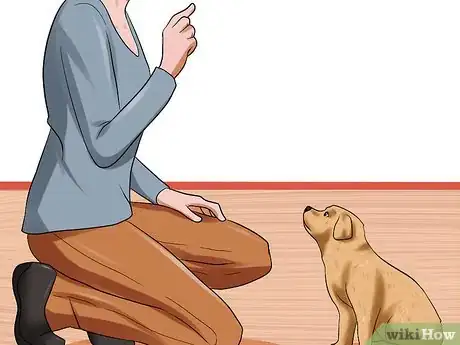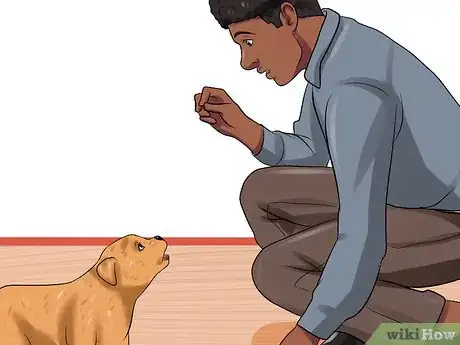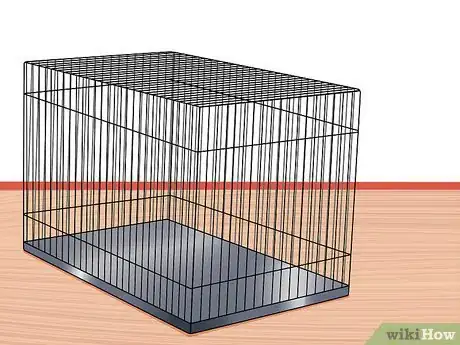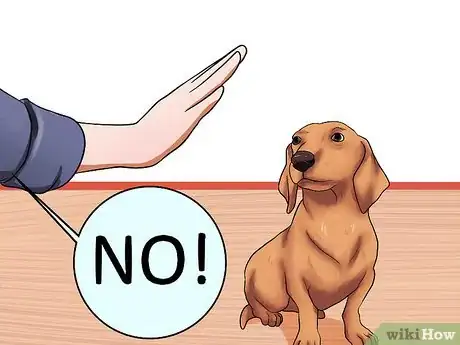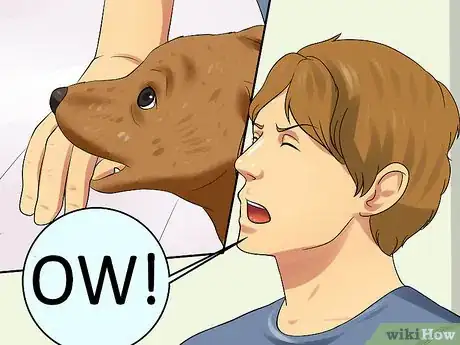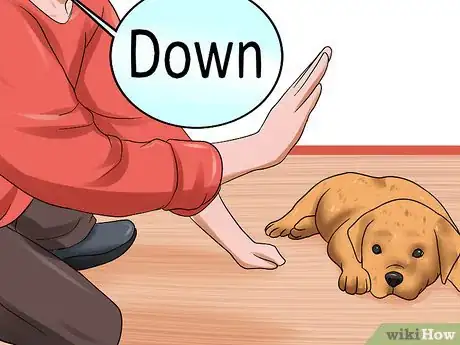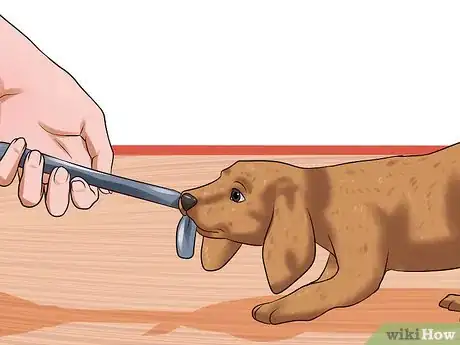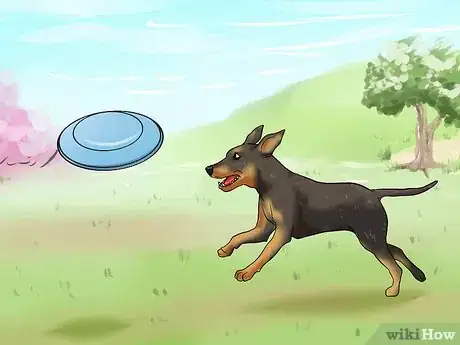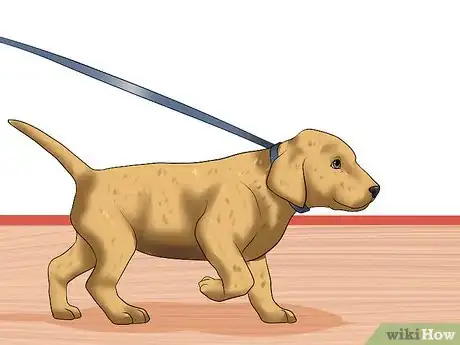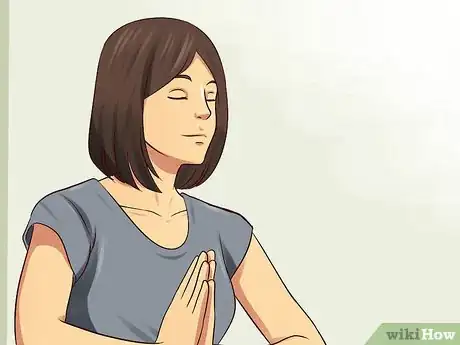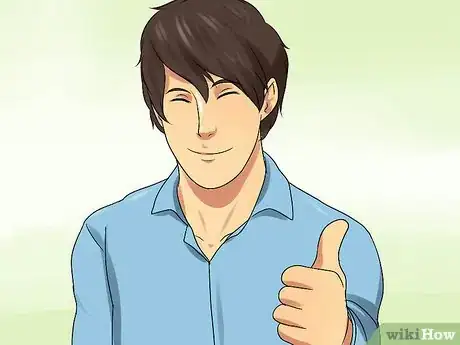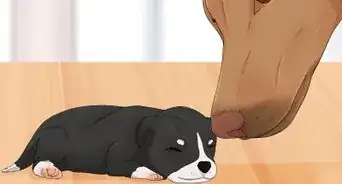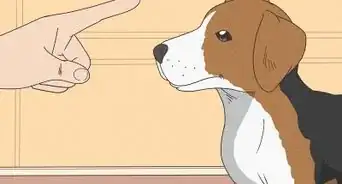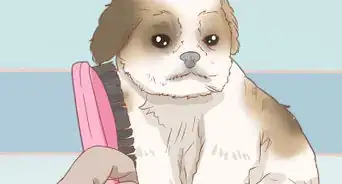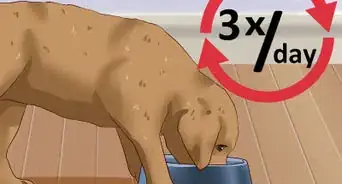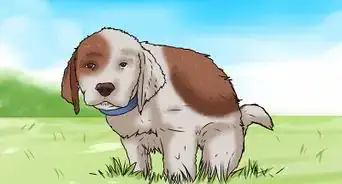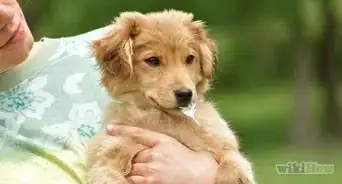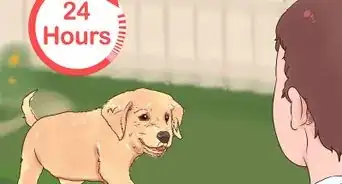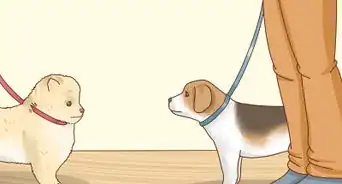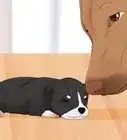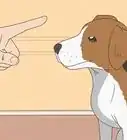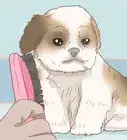This article was co-authored by Jaimie Scott. Jaimie Scott has been training dog owners as the Owner of Jaimie Scott Dog Training in Sacramento, California for the past 15 years. Jaimie meets clients for 1-on-1 training, group classes (owners only, no dogs), as well as live video classes. Jaimie has published videos, blog articles, and eBooks to share tips for training and his personalized insight into dog behavior. With a focus on training the owners, Jaimie believes that dogs need to know who’s in control at any given time in order to feel secure and be happy. Jaimie holds a BS in Mathematics and Computer Science from Pacific University.
wikiHow marks an article as reader-approved once it receives enough positive feedback. In this case, 100% of readers who voted found the article helpful, earning it our reader-approved status.
This article has been viewed 167,519 times.
Is it often said that obedience training for puppies should not start until he is five or six months old, but as soon as you get your puppy home when it will begin learning about you and forming a relationship with you. Typically you take a puppy home when it is eight weeks old and you can begin some basic training almost immediately. Keep it simple and don't chastise or correct your puppy if he is getting things wrong. Remember, he is still very young. Try to have fun together and teach him some basic commands as you play.
Steps
Starting With the Basics
-
1Establish your position. Right from the start you should establish yourself as your puppy's "pack leader" by showing strong leadership, consistency and affection.[1] Puppies will sense your confidence levels, and bad habits can develop at a young age if you are not consistent. This doesn't mean punishing your nine week old puppy if he chews a rug, but is more about clarifying your control over certain aspects, such as when your puppy must be in his crate.[2]
- Be sure you have time set aside to be close to him when he first arrives at your house. He will need careful supervision in the very first weeks.
- Techniques used on older puppies, such making your puppy walk at heel or behind you, or only being fed after you have eaten, will not be so successful with such a young puppy.
- But you can begin to assert your position but not breaking eye contact, and showing him that he is only fed at particular times.
-
2Use your voice. Although your puppy may not yet understand commands, he will respond to your tone of voice. Adjust how you to speak to help your puppy understand what you are saying. As a basic rule deep or low pitched sounds indicate disappointment or disapproval, and high pitched sounds suggest enthusiasm and play. Keep this in mind when you are talking to your puppy.[3]
- Maintain a normal volume for normal talk. This way your dog will understand that raising your voice means increased urgency.
- Talking quietly or whispering can be a very effective way to get a dog's attention.[4]
Advertisement -
3Use a crate. The crate is an essential part of training your puppy and of them learning to live in your house. This is especially the case in the first weeks you have him. The crate is a safe place, like a play pen for a baby, and it can help calm anxious dogs and teach them when to sleep. When your puppy is at this very young stage, he may be required to spend quite a lot of time in their crate, but remember this is just temporary. It is keeping them safe and helping them adapt.
- Help your puppy get used to the crate by initially being home when he is in it. You do not want him to associate the crate with being abandoned.
- Motivate your puppy to enter the crate. You should sit with him after keeping the door close for a few minutes. When your puppy investigates the crate, shower him with a lot of praise and show a lot of enthusiasm. You can also place some treats hidden inside the crate to get your puppy to become curious about the crate.
-
4Refrain from shutting the crate door right away. According to dog trainer Jaimie Scott, "Your dog won't like the crate if it feels like a prison." Instead, Scott suggests "closing the door for a tiny period of time, like 1 second, and gradually working your way up to 5- and 10-second increments. After a long period of gradual training, your dog will love being in the crate." Try to only open the door when he is not whining or crying. You do not want your puppy to learn that crying opens the door.
- Establish it as the place where he sleeps, and if you notice him becoming tired, move him into the crate.
- When he is between 7 and 9 weeks, it is advisable to have him sleep in the crate all night, as well as feeding him in the crate, and leaving him there when you are not at home.
- He will want to keep his crate clean so it's important that you are attentive and take him out if he needs to go outside.
-
5Help him learn to become housebroken. Puppies this young will need to go to the bathroom frequently and won't have the kind of self-control required to stop them peeing on the carpet. It's important to be very attentive at this stage to help your puppy learn that he has to go outside. Dog trainer Jaimie Scott suggests "using pieces of meat as rewards for 1-2 days. Then, wean them off the treats and train them to respond to praise as a reward instead."
- Some of the subtle signs could include him walking a few feet away, walking around in a circles, or sniffing the ground in circles.
- Every time he changes between different activities you should take him outside. So, when he wakes up, stops eating, or stops playing, take him outside.
- If he urinates inside in front of you, just say something like "Bad dog", or "No", and take him outside.
- If he has urinated inside and you didn't see it, don't correct him. He won't understand that he's responsible for a past action.[5]
-
6Deal with chewing. Puppies play with their littermates by chewing on each other, and when he comes home with you he will chew and bite you when you play. Although he is only playing, his sharp teeth can be painful, so it's an important to teach him not to bite you early on. Dog trainer Jaimie Scott advises against "saying 'ow' and pulling your hand away—this only gets your dog more excited and triggers their prey drive." Instead, wait until you think he's about to bite you, then say "no" or "no bite." Then, Scott suggests "giving him praise as positive reinforcement."
- Giving your puppy a command before he does something bad is a much more effective training technique.[6]
- If you discover him chewing your shoes, furniture or anything else he is not supposed to, just stop him chewing it and give him a toy to chew instead.
Learning and Playing
-
1Try some simple commands. You can start teaching your puppy some simple commands even at this young age. Simple commands are crucial for your long-term relationship, and basic obedience training will make your life together easier and more fun.[7] "Sit" is a good place to start. You will just need a few soft treats to help him along. Hold the treat in front of his nose and then slowly tilt his head up and back towards his tail. He will move back into a sitting position, and as he does this, say "sit". Praise him and give him the treat.
- You can teach him "down" by starting from a sitting position and holding the treat in front of his nose. Lower the treat down and he will lower down. Say "down" as he moves and then give him and treat and praise him.
- You may need to keep one hand above his back to discourage him from standing up.
- You can teach him "come", just by moving away from him, holding out a treat, and saying "come".
-
2Play tug of war. Puppies love to play tug of war, and it can be a great way to teach them to drop things on command. After playing for a while say "drop" to instruct him to release the object. If he doesn't let you take it, you can gently blow on his face. This will normally prompt him to drop the object and take a step backwards. Be sure to use the command "drop".
- If blowing doesn't work, gently squeeze one of his front paws. When he feels that his paw is stuck, he will open his mouth, dropping the object, and look down at his paw.
- Always use a gentle voice and remember that at this age it is all about learning while having fun together. Keep the sessions short and be sure to reward good behaviour.[8]
-
3Play fetch. Another great game you can play with a puppy this young is fetch. Playing this will help him learn to retrieve things and bring them back to you. Get two toys that look identical and throw one of them down the hallway. Hopefully the puppy will chase after the object and bring it back to you. If he picks it up and walks towards you but doesn't stop, the trick is to grab him not the toy. If you show that you want the toy too soon, he won't come near you next time.
- Take hold of him as he goes past and praise him for returning. Then you can begin to get him interested in the second toy you are holding.
- He will learn that if he brings something back to you, you will throw something else for him to chase. In the future he will be happy to give up the first toy because he knows there is going to be another one.
-
4Use a leash. If you playing outside with a puppy this young you need to be very attentive. It's a good idea to put him on a long-leash even if you are playing in your garden and there are no escape routes. This will help him get used to being on a leash, but will also enable you to control where he can go. Use a leash of 10-15 feet, but make sure it is light and not too much of a physical burden for such a young puppy.
-
5Be calm and patient. Remember that a puppy of ten weeks old is still very young and his comprehension is limited. Don't try to go too fast too soon, and be patient if he seems not to be picking things up. Puppies can be very easily distracted, so don't allow yourself to be frustrated. Be consistent, stay calm, and have fun. Accidents will happen in these first weeks. Don't have unfair expectations of a ten week old puppy.
-
6Be positive. With a young puppy it's important to reinforce the positive, and ignore the negative where possible. For example, if he chews your shoe that's your fault for leaving it out. When the dog does something wrong remove the dog from the situation, and distract them with an appropriate chew toy. Puppies this young are infants and will not understand you trying to discipline them.
Expert Q&A
Did you know you can get expert answers for this article?
Unlock expert answers by supporting wikiHow
-
QuestionHow long should our training sessions be?
 Pippa Elliott, MRCVSDr. Elliott, BVMS, MRCVS is a veterinarian with over 30 years of experience in veterinary surgery and companion animal practice. She graduated from the University of Glasgow in 1987 with a degree in veterinary medicine and surgery. She has worked at the same animal clinic in her hometown for over 20 years.
Pippa Elliott, MRCVSDr. Elliott, BVMS, MRCVS is a veterinarian with over 30 years of experience in veterinary surgery and companion animal practice. She graduated from the University of Glasgow in 1987 with a degree in veterinary medicine and surgery. She has worked at the same animal clinic in her hometown for over 20 years.
Veterinarian
-
QuestionHow do I train a puppy not to bother an older dog?
 Community AnswerUsually the older dog will take care of that all on its own. If you are afraid the older dog can't fend off the young pup, teach the puppy the "leave it" command. This is where the puppy gets rewarded for immediately stopping whatever he's doing, usually it's something highly interesting or attractive, and returns immediately to the owner. Just be aware, if you don't want him to play with the other dog, you've got to give him an alternative (a treat ball or other puzzle toy can be good if you also need a break).
Community AnswerUsually the older dog will take care of that all on its own. If you are afraid the older dog can't fend off the young pup, teach the puppy the "leave it" command. This is where the puppy gets rewarded for immediately stopping whatever he's doing, usually it's something highly interesting or attractive, and returns immediately to the owner. Just be aware, if you don't want him to play with the other dog, you've got to give him an alternative (a treat ball or other puzzle toy can be good if you also need a break). -
QuestionIf the puppy retrieves the object but runs away, what should I do?
 Community AnswerIntroduce the object again, slowly. Reward the puppy with treats if he has any interest, even if the puppy doesn't necessarily take the object right away. Practice a few times, it will get the hang out it.
Community AnswerIntroduce the object again, slowly. Reward the puppy with treats if he has any interest, even if the puppy doesn't necessarily take the object right away. Practice a few times, it will get the hang out it.
Warnings
- If you are feeling angry, or are at the end of your rope, take a few minutes to collect yourself before handling the issue.⧼thumbs_response⧽
- Everything is fun when you're a puppy. Including electrical cords, hard small plastic bits, and biting. Protect your puppy from itself.⧼thumbs_response⧽
Things You'll Need
- Crate
- Collar
- Food
- Toys
- Brush
- Leash
- Training Pads
References
- ↑ Jaimie Scott. Dog Owner Trainer. Expert Interview. 16 June 2020.
- ↑ https://www.cesarsway.com/dog-training/puppy/starting-your-puppy-off-right
- ↑ http://www.petmd.com/dog/puppycenter/training/evr_dg_using_your_voice_for_training
- ↑ http://www.dogsbestlife.com/home-page/dog-training-use-your-most-important-tool-your-voice/
- ↑ Jaimie Scott. Dog Owner Trainer. Expert Interview. 16 June 2020.
- ↑ Jaimie Scott. Dog Owner Trainer. Expert Interview. 16 June 2020.
- ↑ http://www.rspca.org.uk/servlet/BlobServer?blobtable=RSPCABlob&blobcol=urlblob&blobkey=id&blobwhere=1169720056094&blobheader=application/pdf
- ↑ http://www.rspca.org.uk/servlet/BlobServer?blobtable=RSPCABlob&blobcol=urlblob&blobkey=id&blobwhere=1169720056094&blobheader=application/pdf
About This Article
To obedience train your puppy before it's 10 weeks old, assert your position as "pack leader" right away by not breaking eye contact, maintaining a feeding schedule, and showing lots of affection. Puppies will respond to your tone of voice, so try using a deep voice to indicate disappointment or disapproval and a higher pitched voice to show enthusiasm. Keep in mind that a young puppy won't have much of an attention span, so be patient and keep your training sessions brief. For tips on games you can play to teach obedience, read on!
